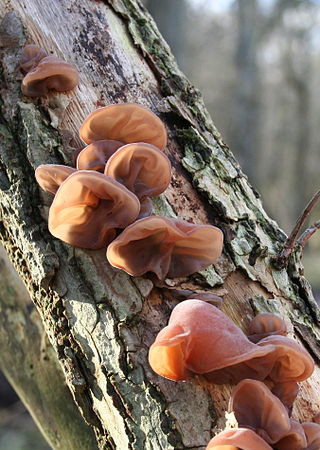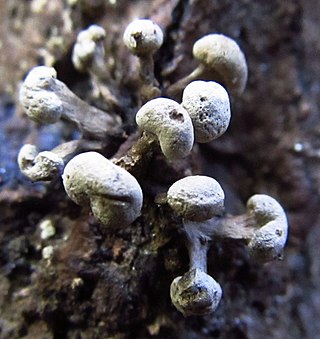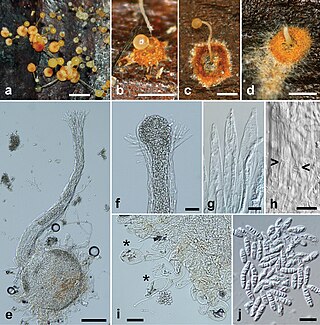
The Auriculariales are an order of fungi in the class Agaricomycetes. Species within the order were formerly referred to the "heterobasidiomycetes" or "jelly fungi", since many have gelatinous basidiocarps that produce spores on septate basidia. Around 200 species are known worldwide, placed in six or more families, though the status of these families is currently uncertain. All species in the Auriculariales are believed to be saprotrophic, most growing on dead wood. Fruit bodies of several Auricularia species are cultivated for food on a commercial scale, especially in China.

The Auriculariaceae are a family of fungi in the order Auriculariales. Species within the family were formerly referred to the "heterobasidiomycetes" or "jelly fungi", since many have gelatinous basidiocarps that produce spores on septate basidia. Around 100 species are known worldwide. All are believed to be saprotrophic, most growing on dead wood. Fruit bodies of several Auricularia species are cultivated for food on a commercial scale, especially in China.

The Hyaloriaceae are a family of fungi in the order Auriculariales. Species within the family have gelatinous basidiocarps that produce spores on septate basidia and, as such, were formerly referred to the "heterobasidiomycetes" or "jelly fungi". All appear to be saprotrophic, growing on dead wood or plant remains. Less than 30 species are currently included within the Hyaloriaceae, but the family has not been extensively researched.

Tremella is a genus of fungi in the family Tremellaceae. All Tremella species are parasites of other fungi and most produce anamorphic yeast states. Basidiocarps, when produced, are gelatinous and are colloquially classed among the "jelly fungi". Over 100 species of Tremella are currently recognized worldwide. One species, Tremella fuciformis, is commercially cultivated for food.

The Atractiellomycetes are class of fungi in the Pucciniomycotina subdivision of the Basidiomycota. The class consists of a single order, the Atractiellales, which contains 3 families, 10 genera, and 58 species.
The Cryptomycocolacomycetes are a class of fungi in the Pucciniomycotina subdivision of the Basidiomycota. The class contains a single order, the Cryptomycocolacales, which in turn contains the single family Cryptomycocolacaceae. The family has two monotypic genera.

The Microbotryomycetes are a class of fungi in the subdivision Pucciniomycotina of the Basidiomycota. The class currently contains eight orders, plus three additional, unassigned families, plus seven additional, unassigned genera. Many species are known only from their yeast states. Species with hyphal states typically produce auricularioid basidia and are often parasitic on other fungi or plants. Several species in the genera Rhodotorula and Sporobolomyces are opportunistic human pathogens.

Sebacina is a genus of fungi in the family Sebacinaceae. Its species are mycorrhizal, forming a range of associations with trees and other plants. Basidiocarps are produced on soil and litter, sometimes partly encrusting stems of living plants. The fruit bodies are cartilaginous to rubbery-gelatinous and variously effused (corticioid) to coral-shaped (clavarioid). The genus has a cosmopolitan distribution.

The Heterogastridiales are an order of fungi in the class Microbotryomycetes. The order contains a single family, the Heterogastridiaceae, which currently contains five genera. Some species in the order are currently known only from their yeast states. Those producing hyphal states have auricularioid basidia and are parasitic on other fungi. Basidiocarps, when present, are minute and variously stilboid (pin-shaped), pustular, or pycnidioid (flask-shaped). Molecular research, based on cladistic analysis of DNA sequences, has shown that the order is a monophyletic (natural) group, though the type and only species of Krieglsteinera has not yet been sequenced and may belong elsewhere.
Colacogloea is a genus of fungi belonging to the class Microbotryomycetes. Most species in the genus are known only from their yeast states. Where known, basidiocarps have auricularioid basidia and occur as parasites on or in the fruit bodies of other fungi.

The Platygloeales are an order of fungi in the class Pucciniomycetes. Species in the order have auricularioid basidia and are typically plant parasites on mosses, ferns, and angiosperms, though Platygloea species appear to be saprotrophic.
The Spiculogloeomycetes are a class of fungi in the subdivision Pucciniomycotina of the Basidiomycota. The class consists of a single order, the Spiculogloeales, together with an additional, unassigned genus, Meniscomyces. Many species are currently known only from their yeast states. Species in the genus Spiculogloea form hyphal states that produce auricularioid basidia and are parasitic on other fungi.
The Platygloeaceae are a family of fungi in the class Pucciniomycetes. Species in the family have auricularioid basidia and are typically plant parasites on angiosperms, though Platygloea species appear to be saprotrophic.
Naohidea sebacea is a species of fungus in the order Naohideales. The order is currently monotypic, having only one family, one genus, and one species. Basidiocarps of Naohidea sebacea form small, gelatinous pustules on wood-inhabiting species of Botryosphaeriaceae. Microscopically, they produce long, slender, auricularioid basidia and amygdaliform (almond-shaped) basidiospores.

The Eocronartiaceae are a family of fungi in the class Pucciniomycetes. Species in the family have auricularioid basidia and are typically plant parasites on ferns and mosses.
Platycarpa is a genus of fungus in the order Platygloeales, containing the single species Platycarpa polypodii. The species forms effused basidiocarps on ferns, on which it is parasitic.
Cystobasidium fimetarium is a species of fungus in the order Cystobasidiales. It is a fungal parasite forming small gelatinous basidiocarps on various ascomycetous fungi on dung. Microscopically, it has auricularioid basidia producing basidiospores that germinate by budding off yeast cells. The species is known from Europe and North America.
Occultifur is a genus of fungi in the family Cystobasidiaceae. Species are parasites of other fungi and, microscopically, have auricularioid basidia and basidiospores that germinate by yeast cells. Several species are currently only known from their yeast states. The genus is distributed worldwide.
Kriegeria is a genus of fungi in the subdivision Pucciniomycotina. The genus is currently monotypic, containing the single species Kriegeria eriophori. The species is a plant pathogen, parasitic on sedges, and produces auricularioid basidia and basidiospores that germinate to form a yeast state.
The Colacogloeaceae are a family of fungi in the class Microbotryomycetes. Members of the family produce yeast states; hyphal states, where known, give rise to auricularioid basidia and are parasitic on other fungi.








